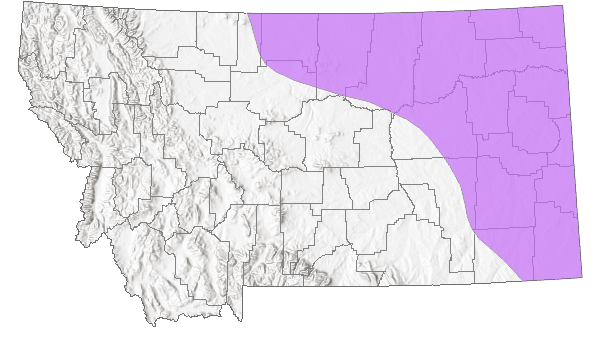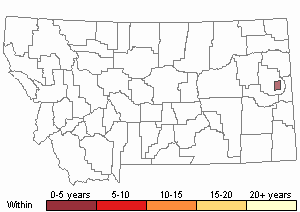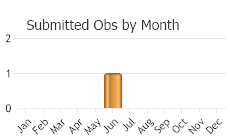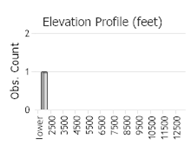View in other NatureServe Network Field Guides
NatureServe
Montana
Utah
Wyoming
Idaho
Wisconsin
British Columbia
South Carolina
Yukon
California
New York
Dusted Skipper - Atrytonopsis hianna
General Description
[From Ferris and Brown 1981; Scott 1986; Layberry et al. 1998; Opler and Wright 1999; Glassberg 2001] Forewing 1.6-1.7 cm. Fairly large, facial area with white above and below black eye giving a masked appearance, wing fringes grayish and uncheckered. Uppersurface dark gray-brown with a three white spots in subapical region of forewing cell, male with tiny stigma. Undersurface gray-brown, lighter gray outwardly.
Phenology
One flight, late May to Mid-June northward, mid-April to mid-May southward; many flights, January to November near the Gulf Coast (Scott 1986). Mainly mid-May to mid-June (Glassberg 2001). Mid-May to mid-June in Canada (Layberry et al. 1998). Mid-May to early June in the Rocky Mountain states (Ferris and Brown 1981). Early May to late June in Colorado (Scott and Scott 1978), mid-May to mid-June in western Nebraska (Johnson and Nixon 1967), mid-May to late June in North Dakota (McCabe and Post 1976).
Diagnostic Characteristics
Best determined by relatively unmarked gray-brown wings, wing fringes uncheckered, facial area with white above and below black eye giving a masked appearance, uppersurface dark gray-brown with a three white spots in subapical region of forewing cell; undersurface gray-brown, lighter gray outwardly.
Species Range
Montana Range
Range Descriptions

 Native
Native
Range Comments
Southeastern Saskatchewan and southern Manitoba, south in west through plains to northern New Mexico and central Texas, east to southern Ontario, New Hampshire, south in east to Gulf Coast; absent over much of Great Lakes region, Louisiana, Florida (Scott 1986; Layberry et al. 1998; Opler and Wright 1999; Glassberg 2001); 1615 m to 2195 m elevation in the Rocky Mountain states, 1829 m to 2195 m elevation in Colorado (Brown 1957; Scott and Scott 1978). Unreported in Montana through 1993 (Kohler 1980; Stanford and Opler 1993), first documented in Blaine and Phillips counties in 1998 (FLMNH Lepidopterists' Society database) and since reported in 8 more eastern counties, west in the north to Hill County, in the south to Custer and Carter counties (Butterflies and Moths of North America database), below 1220 m elevation. Locally uncommon (Glassberg 2001).
Observations in Montana Natural Heritage Program Database
Number of Observations: 1
(Click on the following maps and charts to see full sized version)
Map Help and Descriptions
Relative Density

Recency



 (Observations spanning multiple months or years are excluded from time charts)
(Observations spanning multiple months or years are excluded from time charts)
Migration
Non-migratory.
Habitat
Mixed grass and tallgrass prairie, foothills, barrens, pine woodlands, oak-pine woodlands (Ferris and Scott 1981; Scott 1986; Layberry et al. 1998; Opler and Wright 1999; Glassberg 2001); exclusive to barrens in upper Midwest tallgrass prairie remnants (Swengel and Swengel 2015). Habitat in Montana not described but probably similar.
Food Habits
Larval food plants are grasses, specifically Andropogon gerardii and Schizachyrium scoparium (Shapiro 1965; Heitzman and Heitzman 1974; Ferris and Brown 1981; Scott 1986, 1992, 2006; Layberry et al. 1998). Adults feed on flower nectar (including Allium, Camassia, Cirsium, Erysimum, Fragaria, Penstemon, Rubus, Scutellaria, Thermopsis, Trifolium, Verbena) and mud (Shapiro 1965; Heitzman and Heitzman 1974; Scott 2014).
Reproductive Characteristics
Limited information. Eggs laid (singly?) on undersurface of host plant leaves, hatch in 7-8 days, live in nest of rolled or silk-tied leaves, develop to L7 instar in up to 97-104 days post egg-hatch (all depending on temperature), overwinter (diapause) as L7 instar, pupate 2-8 cm above ground the following spring among the basal clumps of host plant (Heitzman and Heitzman 1974; Scott 1979, 1986, 1992). Males perch throughout the day on or near ground, sometimes patrol exposed rock surfaces, in relatively flat areas near host plant waiting for passing females (Shapiro 1965; Heitzman and Heitzman 1974; Scott 1975b, 1986).
Stewardship Responsibility
References
- Literature Cited AboveLegend:
 View Online Publication
View Online Publication Brown, F.M. 1957. Colorado Butterflies. Proceedings; Numbers Three through Seven. Denver Museum of Natural History, Denver, Co.
Brown, F.M. 1957. Colorado Butterflies. Proceedings; Numbers Three through Seven. Denver Museum of Natural History, Denver, Co. Ferris, C.D. and F.M. Brown (eds). 1981. Butterflies of the Rocky Mountains. Univ. of Oklahoma Press. Norman. 442 pp.
Ferris, C.D. and F.M. Brown (eds). 1981. Butterflies of the Rocky Mountains. Univ. of Oklahoma Press. Norman. 442 pp. Glassberg, J. 2001. Butterflies through Binoculars: A Field Guide to the Butterflies of Western North America. Oxford University Press.
Glassberg, J. 2001. Butterflies through Binoculars: A Field Guide to the Butterflies of Western North America. Oxford University Press. Heitzman, J.R. and R.L. Heitzman. 1974. Atrytonopsis hianna biology and life history in the Ozarks. Journal of Research on the Lepidoptera 13:239-245.
Heitzman, J.R. and R.L. Heitzman. 1974. Atrytonopsis hianna biology and life history in the Ozarks. Journal of Research on the Lepidoptera 13:239-245. Johnson, K. and E. S. Nixon. 1967. The Rhopalocera of northwestern Nebraska. American Midland Naturalist 78:508-528.
Johnson, K. and E. S. Nixon. 1967. The Rhopalocera of northwestern Nebraska. American Midland Naturalist 78:508-528. Kohler, S. 1980. Checklist of Montana Butterflies (Rhopalocera). Journal of the Lepidopterists' Society 34(1): 1-19.
Kohler, S. 1980. Checklist of Montana Butterflies (Rhopalocera). Journal of the Lepidopterists' Society 34(1): 1-19. Layberry, R.A., P.W. Hall, and J.D. LaFontaine. 1998. The Butterflies of Canada. University of Toronto Press. 280 pp. + color plates.
Layberry, R.A., P.W. Hall, and J.D. LaFontaine. 1998. The Butterflies of Canada. University of Toronto Press. 280 pp. + color plates. McCabe, T.L. and R.L. Post. 1976. North Dakota butterfly calendar (including possible strays). Journal of Research on the Lepidoptera 15:93-99.
McCabe, T.L. and R.L. Post. 1976. North Dakota butterfly calendar (including possible strays). Journal of Research on the Lepidoptera 15:93-99. Opler, P.A. and A.B. Wright. 1999. A field guide to western butterflies. Second edition. Peterson Field Guides. Houghton Mifflin Company, Boston, Massachusetts. 540 pp.
Opler, P.A. and A.B. Wright. 1999. A field guide to western butterflies. Second edition. Peterson Field Guides. Houghton Mifflin Company, Boston, Massachusetts. 540 pp. Scott, J.A. 1975b. Mate-locating behavior of western North American butterflies. Journal of Research on the Lepidoptera 14:1-40.
Scott, J.A. 1975b. Mate-locating behavior of western North American butterflies. Journal of Research on the Lepidoptera 14:1-40. Scott, J.A. 1979. Hibernal diapause of North American Papilionoidea and Hesperioidea. Journal of Research on the Lepidoptera 18(3): 171-200.
Scott, J.A. 1979. Hibernal diapause of North American Papilionoidea and Hesperioidea. Journal of Research on the Lepidoptera 18(3): 171-200. Scott, J.A. 1986. The butterflies of North America: a natural history and field guide. Stanford University Press, Stanford, California.
Scott, J.A. 1986. The butterflies of North America: a natural history and field guide. Stanford University Press, Stanford, California. Scott, J.A. 1992. Hostplant records for butterflies and skippers (mostly from Colorado) 1959-1992, with new life histories and notes on oviposition, immatures, and ecology. Papilio new series #6. 185 p.
Scott, J.A. 1992. Hostplant records for butterflies and skippers (mostly from Colorado) 1959-1992, with new life histories and notes on oviposition, immatures, and ecology. Papilio new series #6. 185 p. Scott, J.A. 2006. Butterfly hostplant records, 1992-2005, with a treatise on the evolution of Erynnis, and a note on new terminology for mate-locating behavior. Papilio new series #14. 74 p.
Scott, J.A. 2006. Butterfly hostplant records, 1992-2005, with a treatise on the evolution of Erynnis, and a note on new terminology for mate-locating behavior. Papilio new series #14. 74 p. Scott, J.A. 2014. Lepidoptera of North America 13. Flower visitation by Colorado butterflies (40,615 records) with a review of the literature on pollination of Colorado plants and butterfly attraction (Lepidoptera: Hersperioidea and Papilionoidea). Contributions of the C.P. Gillette Museum of Arthopod Diversity. Fort Collins, CO: Colorado State University. 190 p.
Scott, J.A. 2014. Lepidoptera of North America 13. Flower visitation by Colorado butterflies (40,615 records) with a review of the literature on pollination of Colorado plants and butterfly attraction (Lepidoptera: Hersperioidea and Papilionoidea). Contributions of the C.P. Gillette Museum of Arthopod Diversity. Fort Collins, CO: Colorado State University. 190 p. Scott, J.A. and G.R. Scott. 1978. Ecology and distribution of the butterflies of southern central Colorado. Journal of Research on the Lepidoptera 17(2): 73-128.
Scott, J.A. and G.R. Scott. 1978. Ecology and distribution of the butterflies of southern central Colorado. Journal of Research on the Lepidoptera 17(2): 73-128. Shapiro, A.M. 1965. Ecological and behavioral notes on Hesperia metea and Atrytonopsis hianna (Hesperiidae). Journal of the Lepidopterists' Society 19:215-221.
Shapiro, A.M. 1965. Ecological and behavioral notes on Hesperia metea and Atrytonopsis hianna (Hesperiidae). Journal of the Lepidopterists' Society 19:215-221. Stanford, R.E. 1981. Hesperiodea. In: Ferris, C.D. and F.M. Brown. Butterflies of the Rocky Mountain States. University of Oklahoma Press, Norman. pp. 67-140.
Stanford, R.E. 1981. Hesperiodea. In: Ferris, C.D. and F.M. Brown. Butterflies of the Rocky Mountain States. University of Oklahoma Press, Norman. pp. 67-140. Stanford, R.E. and P.A. Opler. 1993. Atlas of western USA butterflies: including adjacent parts of Canada and Mexico. Unpubl. Report. Denver and Fort Collins, Colorado 275 pp.
Stanford, R.E. and P.A. Opler. 1993. Atlas of western USA butterflies: including adjacent parts of Canada and Mexico. Unpubl. Report. Denver and Fort Collins, Colorado 275 pp. Swengel, A.B and S.R. Swengel. 2015. Grass-skipper (Hesperiinae) trends in midwestern USA grasslands during 1988-2013. Journal of Insect Conservation 19:279-292.
Swengel, A.B and S.R. Swengel. 2015. Grass-skipper (Hesperiinae) trends in midwestern USA grasslands during 1988-2013. Journal of Insect Conservation 19:279-292.
- Additional ReferencesLegend:
 View Online Publication
View Online Publication
Do you know of a citation we're missing? Allen, T.J., J.P. Brock, and J. Glassberg. 2005. Caterpillars in the field and garden: a field guide to the butterfly caterpillars of North America. Oxford University Press.
Allen, T.J., J.P. Brock, and J. Glassberg. 2005. Caterpillars in the field and garden: a field guide to the butterfly caterpillars of North America. Oxford University Press. Brock, J.P. and K. Kaufman. 2003. Kaufman Field Guide to Butterflies of North America. Houghton Mifflin Company, New York, NY 284 pp.
Brock, J.P. and K. Kaufman. 2003. Kaufman Field Guide to Butterflies of North America. Houghton Mifflin Company, New York, NY 284 pp. Forister, M.L., E.M. Grames, C.A. Halsch, K.J. Burls, C.F. Carroll, K.L. Bell, J.P. Jahner, et al. 2023. Assessing risk for butterflies in the context of climate change, demographic uncertainty, and heterogeneous data sources. Ecological Monographs 93(3):e1584. https://doi.org/10.1002/ecm.1584
Forister, M.L., E.M. Grames, C.A. Halsch, K.J. Burls, C.F. Carroll, K.L. Bell, J.P. Jahner, et al. 2023. Assessing risk for butterflies in the context of climate change, demographic uncertainty, and heterogeneous data sources. Ecological Monographs 93(3):e1584. https://doi.org/10.1002/ecm.1584 Opler, P.A. and G.O. Krizek. 1984. Butterflies east of the Great Plains: an illustrated natural history. The John Hopkins University Press, Baltimore, MD. 294 pp.
Opler, P.A. and G.O. Krizek. 1984. Butterflies east of the Great Plains: an illustrated natural history. The John Hopkins University Press, Baltimore, MD. 294 pp.
- Web Search Engines for Articles on "Dusted Skipper"
- Additional Sources of Information Related to "Insects"





